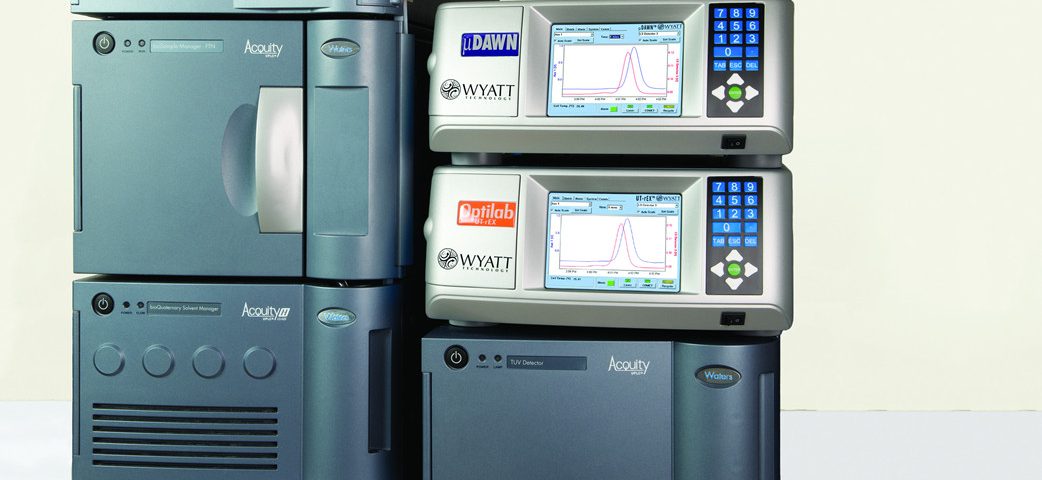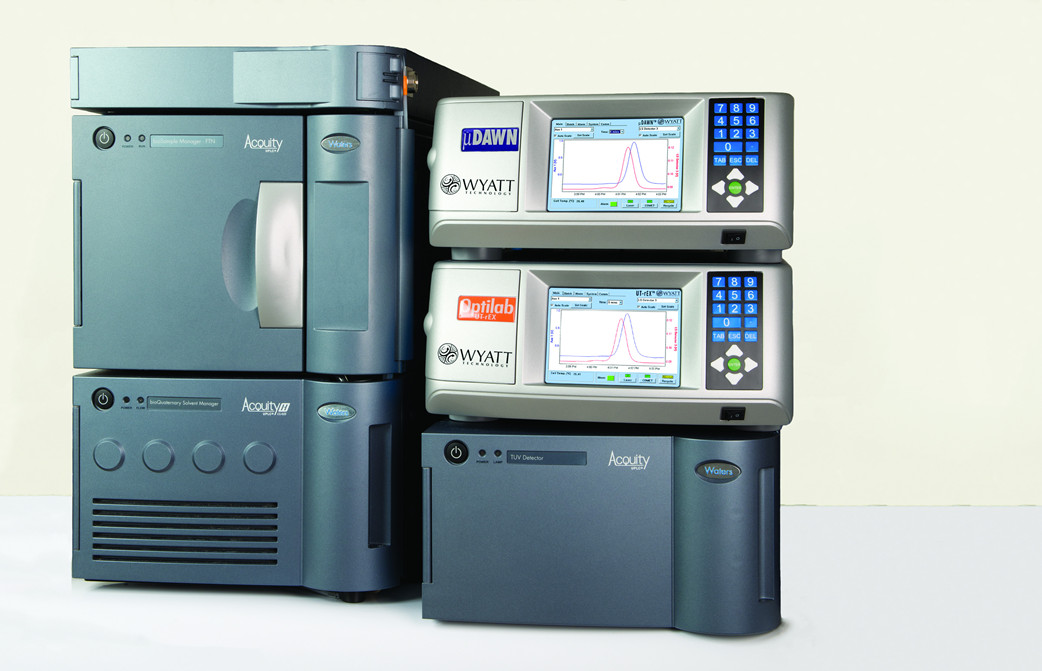The Chromatography Detector You Shouldn’t Miss

Daniel Some, Ph.D., Nov. 20, 2015
The question of 'Which chromatography detector should I buy' was addressed in a recent LinkedIn post by Viet Pham. While Viet gave a great overview of the various detectors available for many types of chromatography, he only briefly alluded to the most important detector type for anyone running size-exclusion chromatography (SEC) or gel-permeation chromatography (GPC): multi-angle light scattering (MALS).
The problem with SEC/GPC
Most types of analytical chromatography rely on column calibration by means of reference molecules. You run the standards and calibrate the retention time according to the molecular property, then inject your own molecules and estimate their properties by interpolating the retention time plot. For most types of chromatography, this is a reasonable approach and not prone to too many sources of systematic error. Tried and true, the methodology is common to a large subset of analyses. On the other hand, SEC/GPC column calibration is, in fact, subject to significant sources of systematic error. That's because the separation principle is only loosely related to the parameter being measured. The size exclusion mechanism is just that - it separates based on size, specifically by hydrodynamic volume, with smaller molecules eluting later than larger molecules due to diffusion into and out of pores in the stationary phase.

What most practitioners would like to actually measure, though, is not hydrodynamic volume, but molecular weight. The relationship between molecular weight and hydrodynamic volume for any given macromolecule depends on conformation and density. Linear polymers have a different relationship than do compact molecules such as branched polymers. Globular proteins have a different relationship than do peptides, partially disordered proteins or multi-domain complexes with extended tertiary structures. So column calibration with typical standards such as linear polymers or globular proteins will often lead to incorrect measurements, if the samples are not similar to the reference molecules in terms of conformation or density.
Are you special?
Some sample types, such as co-polymers, PEGylated or glycosylated proteins, do not have any appropriate calibration standards. Or there may not be a reference molecule suitable for your mobile phase. What's more, non-ideal column interactions can also impact retention time and skew SEC column calibration. Hydrophobic, electrostatic and other non-steric interactions are common examples of such non-ideal behavior. In the case of some large, branched polymers, anchoring of the branches in the GPC packing pores causes later elution of larger molecules, reversing the expected elution order.
Mass spectrometry following LC of course provides very accurate molecular weights, but is subject to several limitations, not the least of which is the inability to represent true solution behavior. Non-covalently bound oligomers usually appear in their monomeric form in mass spec. Heterogeneous samples can create a real mass spec mess.
And the solution is...
So what's a chromatographer to do in order to obtain accurate and reliable, solution-based molar mass measurements? The Solution is Light(TM), as we like to say here at Wyatt Technology. MALS is a first-principles measurement of the molar mass and size of macromolecules in solution, which does not depend on column calibration (please do not confuse with Evaporative Light Scattering, which is a means of measuring concentration, and is always used with column calibration). The combination of MALS with SEC forms a SEC-MALS system, where the only purpose of the column is to effect separation so that the MALS detector measures molecules of one size at any given elution time.
SEC-MALS does not care how the sample interacts with the column, as long as good separation is obtained. The results are accurate and reliable, even if the chromatography is not especially repeatable run-to-run or between mobile phases - no need to recalibrate! A complete SEC-MALS system includes any industry-standard HPLC instrument set, an online MALS detector and an online concentration detector, typically based on UV absorption or differential refractive index (dRI). If you are running UHPLC-SEC for proteins or Waters' APC for polymers, compatible small-volume MALS and dRI detectors are available.
All masses, great and small
SEC-MALS covers a very large range of molar mass, from as little as 200 g/mol and in to the hundreds of million, in fact far larger than may be separated by SEC. For those larger macromolecules and nanoparticles, as well as any that in general don't work well with columns, a different separation method must be used. The most versatile size-based separation technology that is coupled to MALS is Asymmetric Flow Field-Flow Fractionation (AF4). AF4 separates macromolecules and nanoparticles from 1 nm to ~1000 nm, with resolution as good as or better than SEC for most species, and is the technique of choice for a large variety of analytes.
Beyond molar mass
But SEC-MALS provides more than just absolute, first-principles measurements of molar mass. It can also determine molecular size and conformation, and even analyze conjugated molecules such as protein-carbohydrate complexes, glycoproteins, and copolymers.
Size & conformation
For molecules with a rms radius (Rg) greater than about 10 nm, MALS measures size simultaneously with molar mass. The combination of molar mass and size of heterogeneous polymers produces a conformation plot which can be interpreted to understand if a polymer is linear or branched, and the degree of branching. The ratio of size to molar mass will also tell you if a protein is fully folded, partially disordered or denatured, and can be compared with SAXS and electron microscopy data to evaluate the shape of an extended complex.
If your molecules are smaller than 10 nm, their size may be measured with either dynamic light scattering (DLS) or differential viscometry. Because it too uses a laser beam and flow cell, online DLS can be embedded within the MALS detector, eliminating the need for an additional detector that adds dispersion to the chromatographic peaks. Typically (but not always) viscometry is used for polymers and DLS for the more compact proteins.

All masses, great and small.
Conjugates and co-polymers
Conjugated proteins and co-polymers cannot generally be characterized by column calibration since there are no appropriate reference standards. The three-detector system: SEC-UV-MALS-RI is the primary means for their characterization. The combined signals are analyzed to determine the molecular weight of the two constituent species, e.g. protein and carbohydrate or two types of polymers, as well as the total molecular weight.
Surfactant-solubilized membrane proteins, another set of molecules not amenable to column calibration, may also be characterized by this method. Absolute determination of a protein's true oligomeric state in solution, whether a membrane or other type of protein, is one of the most important uses of SEC-MALS in the life sciences.
Characterize with confidence
As scientists and technologists, we want to be sure that the values of molecular properties we report are reliable and repeatable and hence useful. Recognizing that every measurement techniques is subject to sources of bias, random and systematic error, we do the best we can to reduce those. Analytical chemists and biochemists using SEC or GPC who have adopted MALS for absolute molar mass and size determination see their molecules in a whole new light - with new-found confidence in the results and extended characterization capabilities.
Additional resources
- Learn the basics of MALS theory, view a webinar on applications or search for peer-reviewed articles utilizing MALS at www.wyatt.com/Library
- Find out how MALS is used to characterize proteins and polymers at www.wyatt.com/Solutions.
- Check out the unique MALS detectors from Wyatt Technology at www.wyatt.com/Products.

Misjudging the mass can lead to a dire outcome!
